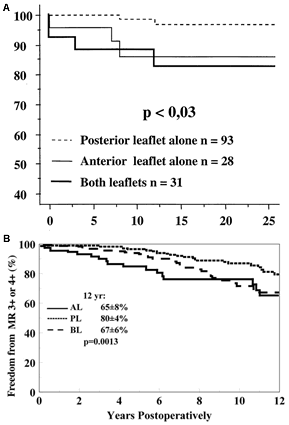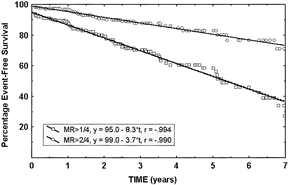Failures and Re-operations
Failure of repair, defined by recurrence of moderate or severe mitral regurgitation, or re-operation for mitral regurgitation are principal endpoints to evaluate the long-term outcomes of mitral valve repair. Failure rates of mitral valve repair are determined principally by the original dysfunction (posterior leaflet, anterior leaflet and bi leaflet) and by repair technique. The longest term follow-up available is for conventional ‘Carpentier’ techniques. Braunberger and colleagues1 reported in 2001 on the long term outcomes of 162 non-rheumatic patients (of whom 90% were degenerative) who underwent a Carpentier repair between 1970 and 1984. They observed that 97% of patients with posterior leaflet, 86% with anterior leaflet and 83% of patients with bileaflet prolapse were free of re-operation at 20 years (Figure 1a). They also found 74% were free from cardiac events at 20 years. The difference between freedom from reoperation and freedom from cardiac event rates, however highlights the limitations of re-operation rate as an outcome measure for mitral repair. Because the decision to undergo reoperation is physician and patient dependent, at least some of those patients with cardiac symptoms had recurrent mitral regurgitation, but never underwent reoperation. In the absence of echocardiographic follow-up, there is no way of quantifying the true long-term failure rate. David and colleagues2 also presented 20 year follow-up for patients (operated between 1981 and 2001) using a variety of repair techniques, including conventional Carpentier techniques and gortex neochordoplasty, and found 96%, 88% and 94% freedom from re-operation rates at 12 years for posterior, anterior and bileaflet prolapse respectively. They also reported on freedom from moderate or severe mitral regurgitation – 80%, 65% and 67% respectively at 12 years (Figure 1b) – however, follow-up echocardiographic data was available for only half of the patients. The lack of systematic echocardiographic follow-up is the major limiting factor in determining the true durability of all mitral repair techniques3; most series have focused on survival and re-operation rates which may not necessarily be reflective of the durability of repair.
The most complete and elaborate follow-up for mitral repair in contemporary literature is probably the series of Flameng and associates4 who report a series of 242 consecutive mitral repairs with serial follow-up echocardiography done at 6 month intervals. They found a freedom from moderate or severe mitral regurgitation of 71% at 7 years and found that new recurrent mitral regurgitation appeared at a rate of 3.7% per year (Figure 2). The data of Flameng and colleagues4 suggest that durability of many mitral repairs is limited; the linear recurrence rate implies that recurrent mitral regurgitation is likely a reflection of progression of underlying valve disease. This hypothesis is supported by data from mitral re-operations after previous repair, as the previous repairs are found to be intact in two-thirds of patients, with recurrent regurgitation usually due to new valve lesions (chordal rupture, fibrosis, calcification, leaflet perforation)5. Technical failure can be a major cause of recurrence, particularly with early failures6, but should be minimal in experienced hands. Some surgical factors that predispose to recurrence of mitral regurgitation include the non-use of an annuloplasty ring, and the technique of chordal shortening.
The edge-to-edge technique is a relatively new repair strategy with limited follow-up compared to Carpentier techniques. One large published series from De Bonis and colleagues7 included 133 patients, followed for a median of 3 years, in whom anterior leaflet prolapse was treated with the edge-to-edge technique; they estimated a 10 year freedom from re-operation of 96.5%, but do not include data that allow computation of the freedom from mitral regurgitation rate.
(*) Modified from A, Braunberger E, Deloche A, Berrebi A, et al: Very long-term results (more than 20 years) of valve repair with carpentier's techniques in nonrheumatic mitral valve insufficiency. Circulation 104(12 Suppl 1):I8-11 2001 Lippincott Williams & Wilkins and B, Reprinted from J Thorac Cardiovasc Surg 130(5), David TE, Ivanov J, Armstrong S, et al, A comparison of outcomes of mitral valve repair for degenerative disease with posterior, anterior, and bileaflet prolapse, 1242-9, Copyright 2005, with permission from the American Association for Thoracic Surgery.
(**) Modified from Flameng W, Herijgers P, Bogaerts K: Recurrence of mitral valve regurgitation after mitral valve repair in degenerative valve disease. Circulation 107(12):1609-13 2003. Lippincott Williams & Wilkins
- 1 Braunberger E, Deloche A, Berrebi A et al. Very long-term results (more than 20 years) of valve repair with carpentier's techniques in nonrheumatic mitral valve insufficiency. Circulation 2001 September 18;104(12 Suppl 1):I8-11.
- 2 David TE, Ivanov J, Armstrong S, Christie D, Rakowski H. A comparison of outcomes of mitral valve repair for degenerative disease with posterior, anterior, and bileaflet prolapse. J Thorac Cardiovasc Surg 2005 November;130(5):1242-9.
- 3Adams DH, Anyanwu A. Pitfalls and limitations in measuring and interpreting the outcomes of mitral valve repair. J Thorac Cardiovasc Surg 2006 March;131(3):523-9.
- 4Flameng W, Herijgers P, Bogaerts K. Recurrence of mitral valve regurgitation after mitral valve repair in degenerative valve disease. Circulation 2003 April 1;107(12):1609-13.
- 5Cerfolio RJ, Orzulak TA, Pluth JR, Harmsen WS, Schaff HV. Reoperation after valve repair for mitral regurgitation: early and intermediate results. J Thorac Cardiovasc Surg 1996 June;111(6):1177-83.
- 6Shekar PS, Couper GS, Cohn LH. Mitral valve re-repair. J Heart Valve Dis 2005 September;14(5):583-7.
- 7 De BM, Lorusso R, Lapenna E et al. Similar long-term results of mitral valve repair for anterior compared with posterior leaflet prolapse. J Thorac Cardiovasc Surg 2006 February;131(2):364-70.

